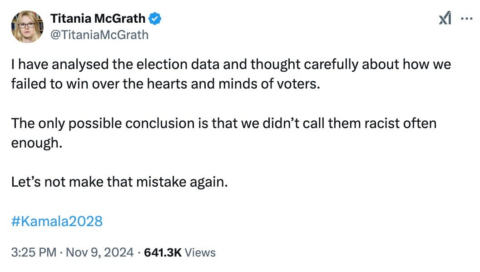Apparently there are still a lot of US politicians who think that letting men compete in womens’ sports is not only okay, but praiseworthy:
Of all the absurdities of the culture war, perhaps the most egregious is the normalisation of the idea that men should be able to identify their way into women’s sports. We are living through a period of mania, so we cannot clearly see how this will look to future generations. But I have little doubt that all those photographs of hulking men towering over women on winners’ podiums will be the memes of the future. “Can you believe they let this happen?” they’ll say, scratching their AI-enhanced cyborg heads.
Wherever one stands on Donald Trump, there can be little doubt that his imminent arrival at 1600 Pennsylvania Avenue will act as a corrective to this problem. Yesterday, the House of Representatives passed the Protection of Women and Girls in Sports Act with its goal of preventing males who identify as female from participating in school sports. If passed into law, schools that attempt to defy the ban would have their federal funds withheld. The bill was introduced by Republican representative Greg Steube of Florida, and makes clear that it will be a violation of federal law “for a recipient of Federal financial assistance who operates, sponsors, or facilitates an athletic program or activity to permit a person whose sex is male to participate in an athletic program or activity that is designated for women or girls”.
One of the most astonishing aspects of the passing of this bill was the voting outcome. 216 Republicans and only 2 Democrats (Vicente Gonzales and Henry Cueller) voted for the motion. Is it really that controversial that sex, as the bill puts it, “shall be recognized based solely on a person’s reproductive biology and genetics at birth”? You will recall the outcry back in November when Democratic politician Seth Moulton admitted that he objected to mixed-sex contact sports in schools. “I have two little girls,” he said, “I don’t want them getting run over on a playing field by a male or formerly male athlete. But as a Democrat, I’m supposed to be afraid to say that”. For this he was branded a “transphobe” and a “Nazi cooperator”, because we all know that one of the top priorities of the Third Reich was the preservation of women’s rights.
Moulton failed to retain his backbone for the latest vote (he called the bill “too extreme”), but his previous comment had been striking for its honesty. He was willing to openly state that fear was the key factor in the reticence of Democrats on this issue. It cannot be the case that only two Democratic members of the House take the view that there is no advantage in sports conferred by male puberty. Surely most of them must have glanced at a biology textbook from time to time. The charitable conclusion is that they have been browbeaten into voting ideologically, not that they genuinely don’t know that there exist anatomical differences between men and women.
Disturbingly, this vote would seem to suggest that the Democrats are not learning their lessons from the election, and instead are determined to double down on the very attitude that cost them the White House.







